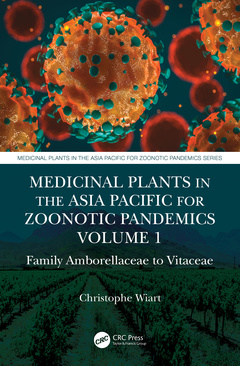Medicinal Plants in the Asia Pacific for Zoonotic Pandemics, Volume 1 Family Amborellaceae to Vitaceae Medicinal Plants in the Asia Pacific for Zoonotic Pandemics Series
Auteur : Wiart Christophe

Medicinal Plants in the Asia Pacific for Zoonotic Pandemics provides an unprecedented, comprehensive overview of the phylogeny, botany, ethnopharmacology, and pharmacology of more than 100 plants used in the traditional medical systems of Asia and Pacific. It discusses their actions and potentials against viruses, bacteria, and fungi that represent a threat of epidemic and pandemic diseases, with an emphasis on the molecular basis and cellular pathways.
This book presents scientific names, the botanical classification, traditional medicinal uses, active chemical constituents, and pharmacology. This volume is a critical reference for anyone involved in the discovery of lead molecules or phytopharmaceutical products for the prevention or treatment of pandemic viral, bacterial, or fungal infections.
FEATURES
- Phylogenetic presentation of medicinal plants and a chemotaxonomical rationale of antiviral, antibacterial, and antifungal actions
- Discusses the chemical structure?activity relationship, pharmacokinetics, and oral bioavailability of antimicrobial principles
- Introduces the molecular mechanism of natural products on viruses, bacteria, and fungi
- Contains a selection of botanical plates and useful bibliographic references
This book is a useful research tool for postgraduates, academics, and the pharmaceutical, herbal, and nutrition industries. Medicinal Plants in the Asia Pacific for Zoonotic Pandemics includes commentary sections that invite further research and reflection on the fascinating and timely subject of the development of drugs and herbals from Asia-Pacific medicinal plants to safeguard humanity and other life forms against the forthcoming waves of viral, bacterial, or fungal pandemics. This book is an ideal reference text for medicinal plant enthusiasts.
1. The Clade Protomagnoliids 2. The Clade Magnoliids 3. The Clade Monocots 4. The Clade Ranunculids 5. The Clade Core Eudicots 6. The Clade Rosids
Christophe Wiart, PharmD, PhD, is an associate professor of the School of Pharmacy of the University of Nottingham, Malaysia Campus. His fields of expertise are Asian ethnopharmacology, chemotaxonomy, and ethnobotany. He has collected, identified, and classified several hundred species of medicinal plants from India, Southeast Asia, and China.
Dr. Wiart appeared on HBO’s Vice (TV series) in season 3, episode 6 (episode 28 of the series), titled "The Post-Antibiotic World and Indonesia’s Palm Bomb," April 17, 2015. It highlighted the need to find new treatments for infections that were previously treatable with antibiotics but are now resistant to multiple drugs. "The last hope for the human race’s survival, I believe, is in the rainforests of tropical Asia," said ethnopharmacologist Christophe Wiart. "The pharmaceutical wealth of this land is immense."
He currently supervises several PhD students working on the discovery of novel antibacterial, anticancer, antiinflammatory, and antioxidant agents from medicinal plants. Dr. Wiart has written several reference books on the medicinal plants of Asia.
Date de parution : 06-2021
17.8x25.4 cm
Date de parution : 06-2021
17.8x25.4 cm
Thèmes de Medicinal Plants in the Asia Pacific for Zoonotic... :
Mots-clés :
Middle East Respiratory Syndrome Coronavirus; Medicinal plants; Herpes Simplex Virus Type-1; Asia; Herpes Simplex Virus; Viral infection; Dibenzocyclooctadiene Lignan; Bacterial infections and resistence; Inhibition Zone Diameters; Pandemic; Mic Value; Nosocomial bacteria; Botanical Observation; Methicillin Resistant Staphylococcus Aureus; Selectivity Index; Maximum Nontoxic Concentration; Severe Acute Respiratory Syndrome Coronavirus; High Throughput Screening; Madin Darby Canine Kidney Cells; Protoberberine Alkaloid; Cissus Quadrangularis; HIV-1 Inhibitor; Benzophenanthridine Alkaloid; Respiratory Syndrome Coronavirus; Human Immunodeficiency Virus Type-1 Protease; Zoonotic Influenza; HCV Replication Inhibitor; Antimicrobial Profiles; HIV Type-1; HIV



